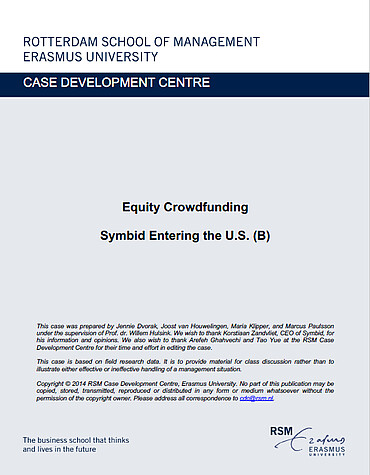Abstract
In April 2013, following the liberalization of securities regulation, the U.S. government signed an act into law which finally legalized equity-based crowdfunding in this market. With the U.S. being the largest equity financing market in the word, the new law presented great opportunities for equity crowdfunding companies such as Symbid, looking to expand their operations internationally. Symbid, a Dutch start-up active in the global crowdfunding market, was established based on the foundations of a new financing system that allowed the company to set the stage for equity-based crowdfunding in Europe. Once the company’s reputation was well established in the Dutch market, Symbid embarked on a subsequent journey with the aim of expanding their business through internationalization. Following a range of both successful and unsuccessful strategies, Symbid was now looking at entering the U.S. market. Faced with substantial competition, the company had only one shot to perfect their entrance strategy, leaving Symbid with a challenge that could determine its future.The case confronts the reader with the challenge of Symbid in entering the previously uncontested U.S. market, by considering either a niche marketing strategy directed at female entrepreneurs, or a mass marketing approach. The main case compares these two approaches. And the B Case elucidates the actual decision that Symbid has made. Aside from highlighting the internationalization process of a start-up, the case also provides a picture of entrepreneurial financing and the importance of equity-based crowdfunding.
Citation Note
Based on field research; 2 pages. Follow the 'handle' link to access the Case Study on RePub. For EUR staff members: the Teaching Note is available on request, you can contact us at rsm.nl/cdc/contact/ For external users: follow the link to purchase the Case Study and the Teaching Note.
Objective
The case has three main teaching objectives: 1. Highlight the importance of right market selection in an internationalization process. The case provides the reader with a background on the past internationalization process of Symbid in Europe as well as the future plans regarding entry on the U.S. market. By studying past experiences and the incentives for entering the U.S. market for Symbid, the importance of right market selection in an internationalization process is understood. 2. Raise awareness of the advantages and disadvantages associated with a marketing strategy targeting a broad or niche audience. With many competitors eager to enter U.S., competition is foreseen to be fierce within the crowdfunding market. Swift and decisive actions are essential in order to establish a strong position on the market. Based on associated advantages and disadvantages, Symbid needs to decide whether to have marketing strategy that targets a broad or niche target audience. Using the case it is possible to discussion which approach would benefit Symbid the most and consequently advocate for one of the two. 3. Create a deeper understanding of the crowdfunding market and its role in stimulating entrepreneurship. The case of Symbid allows for the reader to gain an insight of the crowdfunding market. It also covers important developments currently taking place in terms of equity-based crowdfunding. In understanding the potential for stimulating the successful establishment of new ventures, the importance of this form of financing for entrepreneurs becomes clear for the students.
